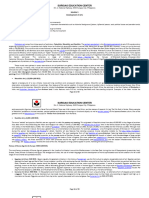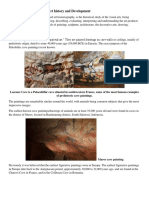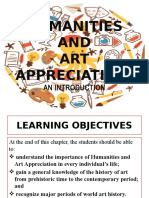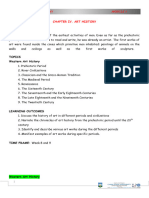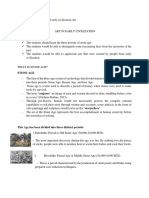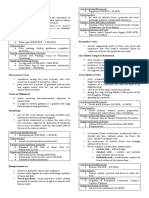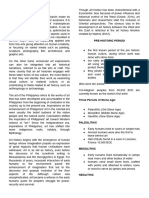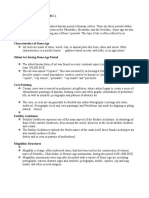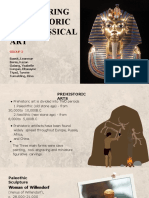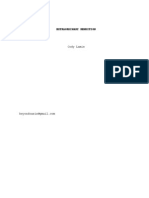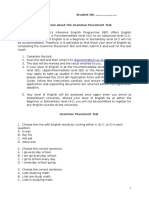Gned 01 - Module 4 - Art in Today's Society
Gned 01 - Module 4 - Art in Today's Society
Uploaded by
Renato KelisteCopyright:
Available Formats
Gned 01 - Module 4 - Art in Today's Society
Gned 01 - Module 4 - Art in Today's Society
Uploaded by
Renato KelisteOriginal Title
Copyright
Available Formats
Share this document
Did you find this document useful?
Is this content inappropriate?
Copyright:
Available Formats
Gned 01 - Module 4 - Art in Today's Society
Gned 01 - Module 4 - Art in Today's Society
Uploaded by
Renato KelisteCopyright:
Available Formats
CAVITE STATE UNIVERSITY NAIC
(Formerly Cavite College of Fisheries)
Bucana Malaki, Naic, Cavite
PROF. ZARITA A. MANALO
ART HISTORY MODULE 4
ART HISTORY
OVERVIEW
When exactly did art begin? The survival of art is dependent upon its ability to evolve
hence, to change with the times. The art today is very different from the art of yesterday not
only in terms of the techniques of execution. Even the viewers today are a lot different from
that of previous decades and centuries. History, and particularly art history, is as much a
projection of the present as it is an authentic documentation of the past (Kissick, 1996).
LESSONS
1. Art History
2. Art in Today’s Society
LEARNING OUTCOMES
After the completion of the module you will be able to:
1. determine the different forms of art in the past and in today’s society
2. discuss the trends of art from various periods in the Philippines; and
3. identify and familiarize with recognitions and awards given to artists and artisans.
LET’S GET STARTED
Multiple Choice. Choose the letter of the correct answer.
1. This is the oldest surviving three-dimensional depiction of human body, approximately
8,000 to 10,000 years and might be a fertility goddess or goddess that brings prosperity and
good fortune.
a. Lascaux Cave Painting c. Stonehenge
b. Mesopotamian Art d. Venus of Willendorf
2. This great structure is characterized by the body of a lion and a human head.
a. Great Sphynx c. Portal guardian
b. Parthenon d. Pyramid
3. This Asian art is characterized by holy symbols like the om, swastika and lotus flower.
a. Chinese c. Japanese
b. Hindu d. Thailand
4. This technique is a trait of baroque art and is characterized by dimly lit scenes and
dramatic atmosphere.
a. Blending c. Linear perspective
b. Chiaroscuro d. Sfumato
5. It is the product of industry and commercialism.
a. Appropriation c. Hybrid Art Form
b. Art Fusion d. Improvisation
GNED 01 – ART APPRECIATION 1
ART HISTORY MODULE 4
ART HISTORY
STONE AGE ( 30,000 BCE – 2500 BCE)
The Lascaux Caves Paintings
The Lascaux caves in the south of France ar3e considered
among the most exquisite and well-preserved examples of
prehistoric culture. The paintings are found on the walls and
ceilings of the caves.
Venus of Willendorf
This is oldest surviving 3D depiction of human body, approximately
8,000 to 10,000 years older than the images at Lascaux.
It might be a fertility goddess or goddess that brings forth prosperity
and good fortune.
Stonehenge
This is one of the most famous surviving Neolithic-style
structures located in Southern England. Today it stands with
approximately the same configuration as it did around 1300
BCE. Most likely, it was constructed as a shrine, the outer of its
two concentric rings has the distinction of being laid out in
exact accordance with the directional path of the sun at the
summer solstice.
MESOPOTAMIAN
(3500 BCE-539 BCE)
Mesopotamian Art Standard of Ur
Mesopotamian art features a distinctive style in the sculptures. Textures of the
figures are achieved through repetition of lines or dots. The most impressive works are the
so-called portal guardians. They are usually presented as animals (real or imagined) or
animals with human heads.
GNED 01 – ART APPRECIATION 2
ART HISTORY MODULE 4
Ishtar Gate
It was the eighth gate to the inner city of Babylon and
constructed in about 575 BCE by order of
King Nebuchadnezzar II on the north side of the city.
It was excavated in the early 20th century, and a
reconstruction using original bricks, completed in 1930, is
now shown in Berlin’s Pergamon Museum.
Stele of Hammurabi
Created in 1750 BCE, the tall black stele contained 282 laws
decreed by a Babylonian king known as Hammurabi.
EGYPTIAN (3100 BCE-30BCE)
The Pyramids of Giza
Pharaoh Khufu began the first Giza pyramid project, circa 2550
B.C. His Great Pyramid is the largest in Giza and towers some
481 feet (147 meters) above the plateau. It is estimated 2.3
million stone blocks. Each weighs an average of 2.5 to 15 tons.
The Great Sphinx of Giza
This is the most recognizable statue associated with ancient
Egypt and among the most famous in the world. The sculpture, of
a recumbent lion with the head of an Egyptian king, was carved
out of limestone on the Giza plateau.
This was probably during the reign of the King Khafre in the
period of the Old Kingdom of Egypt. The Great Sphinx is seen by
historians as seemingly guarding the pyramids.
GREEK AND HELLENISTIC (850 BCE-31 BCE)
The Parthenon: The Temple of Athena The Winged Victory of Samothrace
Three distinct styles of Greek sculpture
1. Archaic – stiff and rigid
2. Classical – realistic and includes the representation of movements.
3. Hellenistic – human form
GNED 01 – ART APPRECIATION 3
ART HISTORY MODULE 4
ROMAN (500 BCE-CE 476)
Colosseum
Accommodated approximately 50,000 people. In this
arena were held gladiator fights, naval battles, and
even prosecutions to the delight of the emperor and
the crowd.
HINDU, CHINESE AND JAPANESE (656 BCE-CE 1900)
Hindu art reflects a plurality of beliefs. It is also characterized by holy
symbols, which includes the om, which is an invocation of the divine
consciousness of God; the swastika, a symbol of auspiciousness; and the
lotus flower, a symbol of purity, beauty, fertility and transcendence.
Shiva as Lord of Dance
(Nataraja)
Chinese artistic styles are classified according to the dynasty under
which they were produced. Chinese art encompasses fine arts, folk
arts and performance arts.
Guo Xi: Early Spring(Song Dynasty)
Japanese art covers a wide range of art styles and media, including
ancient pottery, sculpture, ink painting and calligraphy on silk and paper,
ukiyo-e paintings and woodblock prints, kirigami, origami, dorodango,
and more recently manga, a modern method of Japanese cartooning
and comics.
BYZANTINE AND ISLAMIC (476 CE-1453 CE)
Byzantine mosaic The Hagia Sophia (Church of Holy Wisdom)
Byzantine art is about religious expression and more specifically about church theology
translated into aesthetic forms.
GNED 01 – ART APPRECIATION 4
ART HISTORY MODULE 4
MIDDLE AGES (500-1400)
During the 14th century, European thinkers, writers and writers considered the period the fall
of Rome as a “Middle” or even “Dark” age. In this period, no scientific accomplishments had
been made, no great art produced, no great leaders born. The Middle Ages, however, can
still be proud of the architectures and sculptures that were created solely for the purpose of
religion. Beautiful Romanesque castles and majestic gothic cathedrals were created.
Notre dame Cathedral
The cathedral was begun in 1160 and largely completed by 1260,
though it was modified frequently in the following centuries.
Chartres Cathedral
(also known as the Cathedral of Our Lady of Chartres)
This a Roman Catholic Church in Chartres, France, about 80 km
(50 miles) southwest of Paris. Mostly constructed between 1194
and 1220. It is designated a World Heritage Site by UNESCO,
which calls it "the high point of French Gothic art" and a
"masterpiece".
EARLY AND HIGH RENNAISSANCE (1400-1550)
Renaissance literally means rebirth and describes the revival of interest in the artistic
achievements of Classical world (of Greece and Rome). It was a time when individual
expression and worldly experience became two of the main themes of Renaissance art.
“David” by Donatello “David” by Michelangelo “The Birth of Venus” by Botticelli
“The Creation of Adam” by Michelangelo “The Last Supper” by Leonardo da Vinci
GNED 01 – ART APPRECIATION 5
ART HISTORY MODULE 4
“Mona Lisa” by Leonardo da Vinci
Mona Lisa, also called Portrait of Lisa Gherardini, wife of Francesco del
Giocondo, Italian La Gioconda, or French La Joconde, oil painting on a
poplar wood panel by Leonardo da Vinci, probably the world’s most
famous painting. It was painted sometime between 1503 and 1519, when
Leonardo was living in Florence, and it now hangs in the Louvre Museum,
Paris, where it remained an object of pilgrimage in the 21st century. The
sitter’s mysterious smile and her unproven identity have made the painting
a source of ongoing investigation and fascination. (Britannica)
VENETIAN AND NORTHERN RENAISSANCE (1430-1550)
The Northern Renaissance was famous for its advanced techniques in oil painting, realistic,
expressive altarpiece art, wooden panel paintings, woodcuts and printmaking. Stone
sculpture was not very popular, but the Germans boast of their wood-carving techniques.
“Through the Looking Glass”
by Jan van Eyck
“Madonna and the Child”
by Giovanni Bellini
MANNERISM (1527-1580)
In mannerism, paintings and compositions can have no focal point and space can be
ambiguous. The figures can be presented by an athletic bending and twisting with
distortions, exaggerations, elongation of the limbs, bizarre posturing on one hand, graceful
posturing on the other hand, and a rendering of the heads as uniformly small and oval.
Compositions are marked by clashing colors, which lacks the balance, naturalism and
dramatic colors of the High Renaissance.
“Christ cleaning the Temple” Doménikos Theotokópoulos
by El Greco “El Greco”
GNED 01 – ART APPRECIATION 6
ART HISTORY MODULE 4
BAROQUE (1600-1750)
The word baroque describes something that is elaborate and highly detailed. The popularity
of the style was encouraged by the Catholic Church. The arts communicate religious themes
and direct emotional involvement in response to the Protestant Reformation. The Barouque
style is characterized by exaggerated motion and clear detail used to produce drama,
exuberance, and grandeur in sculpture, painting, architecture, literature, dance and music.
Chiaroscuro technique is a trait of Baroque art. This technique refers to the interplay
between light and dark, often used in paintings with dimly lit scenes to produce a very high
contrast, dramatic atmosphere.
Palace of Versailles Chiaroscuro
NEOCLASSICAL (1750-1850)
Neoclassical painting and sculpture involved an emphasis on austere linear design in the
depiction of classical events, characters and themes, using historically correct settings and
costumes. Art in this period recaptures Greco-Roman grace and grandeur.
Napoleon Crossing the Alps Jacques-Louis David Cupid and Psyche Antonio Canova
by Jacques-Louis David by Antonio Canova
ROMANTICISM (1780-1850)
Romantic visual and literary artists glorified THINGS (abstract, complex concepts like liberty,
peace, survival, hope, heroism, despair and other sensations that nature evokes in human.
Liberty Leading the People Eugène Delacroix
by Eugène Delacroix
GNED 01 – ART APPRECIATION 7
ART HISTORY MODULE 4
REALISM (1848-1900)
Realists wanted to portray ‘real’ people in real situations with truth and accuracy, including
all the unpleasant aspects of life. The realist artists portrayed everyday subjects and
situations in contemporary settings, and aimed to depict individuals of all social classes in a
similar manner.
The Gleaners Jean Francois Millet
by Jean Francois Millet
IMPRESSIONISM (1865-1885)
The movement emphasizes an artist’s immediate impression of the moment or scene,
communicated through the effect of light and its reflection, short brushstrokes, and
separation of colors. Artists painted quickly and freely.
The Houses of Parliament Claude Monet
at Sunset by Claude Monet
POST-IMPRESSIONISM (1885-1910)
Post-Impressionism bridged the gap between the restrictive techniques found in the
Impressionist period and the emphasis on geometry found in modern art. Post-Impressionist
art used motif such as nature, architecture, scenes of daily life and even still life.
The Starry Night Vincent Van Gough
by Vincent Van Gough
GNED 01 – ART APPRECIATION 8
ART HISTORY MODULE 4
FAUVISM AND EXPRESSIONISM (1900-1935)
Fauvism is a term used to denote the use of distortion and exaggeration for emotional effect.
Fauve artists used pure, brilliant color applied straight from the paint tubes to create bright
effects on the canvas.
Expressionism is an artistic style in which the artist attempts to portray not objective reality
but rather the subjective emotions and responses that objects and events arouse in him.
Expressionism is a highly subjective, personal, spontaneous self-expression typical of the
wide range of modern artists and art movements of today.
CUBISM, FUTURISM, SUPREMATIVISM, CONSTRUCTIVISM, DE STIJL (1905-1920)
Cubism is an art artistic movement, created by Pablo Picasso and Georges Braque. It
employs geometric shapes in depictions of human and other forms.
Futurism is an Italian art movement that took speed, technology and modernity as its
inspiration. Futurism portrayed the dynamic character of 20th century life, glorified war and
the machine age, and favored the growth of fascism.
DADA AND SURREALISM (1917-1950)
Dadaism aimed to generate difficult questions about society, the role of the artist, and the
purpose of art. Dada artists are known for their use of readymade objects – everyday objects
that could be bought and presented as art with little manipulation.
Surrealism’s aim is to channel the unconscious as a means to unlock the power of the
imagination. The movement was also influenced by Karl Marx. The surrealists hoped that the
human psyche had the power to reveal the contradictions in the everyday world and spur on
revolution.
ABSTRACT EXPRESSIONISM (1940s -1950s) and POP ART (1960s)
Abstract Expressionism is also known as Action Painting or Color Field Painting. It entered
the art scene after World War II with its characteristic messiness and extremely energetic
applications of paint.
Pop Art is a movement marked by a fascination with popular culture reflecting the affluence
in a post-war society. It was prominent in American art but soon spread to Britain. In
celebrating everyday objects such as soup cans, washing powder, comic strips and soda
pop bottles, the movement turned the commonplace into icons.
POSTMODERNISM AND DECONSTRUCTIVISM (1970-)
Postmodern artists use familiar images from consumer and pop culture and mass media to
confront or question art and society. They include minorities and women who were not
previously part of the art establishment.
GNED 01 – ART APPRECIATION 9
ART HISTORY MODULE 4
ART IN TODAY’S SOCIETY
SOUL-MAKING
In the language that refers to all activities concerning individual expression through
the arts, is the deeper process known as “soul-making”. The soul here refers to individual’s
psyche. Expressing this state of the psyche through the arts enables the individual to find
new life meanings that he is able to share to others.
Soul-making is art creation, art making is the expression of the artist psyche, a
manifestation of his soul (“Soul-making, 2009)
ART FUSION
Art fusion is a product of industry and commercialism. It occurs
when an artist of any art form collaborate with a brand/ company (a product,
service, fashion, charity) to create a product that will benefit the artist, the
company, and society as a whole.
Salvatore Dali and Elsa Schiaparelli – first fine artist and fashion
designer to engage in art fusion in 1933.
Andy Warhol and Yves Laurent collaborated in the 1960s.
TRANSCREATION
Transcreation is a term used in advertising and
marketing and refers to the process of adapting a message from
one language to another, while maintaining its intent, style, tone
and context. Examples would be changing the music to text, text
to dance, dance to visual art, text to theatre and text to cinema.
HYBRID ART FORMS
A hybrid is defined as having mixed origin or composition that
adds variety or complexity to a system. In art forms, hybrid could mean
the blurring of traditional distinct boundaries between artistic media
such as painting, sculpture, film, performance, architecture, and dance.
It may involve cross-breeding the art-making process with other
disciplines, like with the natural and physical sciences, industry,
technology, literature, popular culture, and philosophy.
Hybrid art forms in the contemporary arts explore the various media and techniques
for innovation and experimentation in art creation.
APPROPRIATION
Appropriation is borrowing. It is the practice of creating a new work by taking a
preexisting image/ material from another source like books, advertisements, internet and
combines it with new ones, thus completely transforming the
original.
Some common sources of appropriated images are
works of art from the distant or recent past, historical
documents, media (film and television), or consumer culture (advertisements or products).
GNED 01 – ART APPRECIATION 10
ART HISTORY MODULE 4
IMPROVISATION IN VARIOUS ART FORMS
The word improvise means to compose, perform or deliver without previous
preparation; or to extemporize, play, recite and sung on the spur of the moment.
Improvisation is creating or performing something spontaneously or without
preparation, or making something functional from whatever is available.
Improvisation in the performing arts is a spontaneous performance without specific or
scripted preparation (e.g. adlib)
In music, for instance, improvisation is the composition or simultaneous playing of
music, without prior preparation or practice. Dance improvisation is frequently used in
choreography.
Photorealism
Photorealism is a term that was invented to refer to artists
whose work depended largely on photographs. These artists would
often project onto the canvas the images which would be replicated
with precision and accuracy.
The movement began in the same period as Conceptual Art,
Pop Art and Minimalism. Photorealism expressed a strong interest in realism in art, over that
of idealism and abstraction.
Installation Art
Installation art is a modern movement that is characterized by
massive, immersive, and sometimes interactive works of art.
Installation artists usually create these pieces for specific
locations, enabling them to transform the space into a customized,
interactive environment.
Installation artworks often occupy an entire room or gallery
space.
The following are the major characteristics of art installations:
Immersive – a major characteristic of installation art is its ability to physically interact
with viewers.
Large-Scale – because installation art is interactive in nature, most works are
massive or large in scale. Their size overwhelms the viewers and enables them to
become completely immersed in this environment.
Site-Specific – before the artists create their massive installations, they usually plan it
with certain sites already in mind. These areas may be rooms in galleries, museums
or outdoor spaces.
Applied Arts
Applied Arts refers to the application of artistic designs and decorations to everyday
utilitarian objects to make them aesthetically pleasing. This includes industrial design,
fashion design, and commercial art.
Fashion – is defined as a popular way of dressing at a particular time and place,
and among a particular group of people. Fashion design is the art of applying
design and aesthetics or natural beauty to clothing and accessories.
Furniture design – is a specialized field where the function and aesthetics are
brought together. Interior designers believe that furniture is one of the most
important aspects of an interior design.
GNED 01 – ART APPRECIATION 11
ART HISTORY MODULE 4
Please visit the following links:
Online Museum (virtual tour)
https://www.facebook.com/PinasForwardPH/posts/945733255848390
Timeline of Art History
https://www.identifythisart.com/timeline-of-art-history/
The Evolution of Art
https://www.youtube.com/watch?v=bkWHrWw5yTg
Top 10 Painters of All Times
https://www.youtube.com/watch?v=t4ftkrHtDd4
Top 10 Greatest Filipino Artists and Their Masterworks
https://www.youtube.com/watch?v=RPpTpPhb0Ck&t=46s
GAMABA Awardees
https://www.youtube.com/watch?v=0eNUYhuOOkg
Street Art and Corona Virus
https://www.youtube.com/watch?v=FxsqQpLVeFY
ACTIVITY 7
APPROPRIATION
Appropriation is borrowing. It is the practice of creating a new work by taking a
preexisting image/ material from another source like books, advertisements, internet and
combines it with new ones, thus completely transforming the
original.
Make an appropriation of a popular painting using
photography.
https://www.youtube.com/watch?v=UeBgxIYvwY4&t=23s
REFERENCES:
Ferrer, M.C.D, Mangahas, T.L. S, Geron, C.DT, Santos, M.S., Velasco, V.V, and Trinidad,
J.L F. (2018). Art Appreciation. Panday-Lahi Publishing House, Inc.
Online museum. Retrieved at
https://www.facebook.com/PinasForwardPH/posts/945733255848390
Timeline of Art History. Retrieved at https://www.identifythisart.com/timeline-of-art-history/
The Evolution of Art. Retrieved at https://www.youtube.com/watch?v=bkWHrWw5yTg
Top 10 Painters of All Times. Retrieved at https://www.youtube.com/watch?v=t4ftkrHtDd4
Top 10 Greatest Filipino Artists and Their Masterworks. Retrieved at
https://www.youtube.com/watch?v=RPpTpPhb0Ck&t=46s
GAMABA Awardees. Retrieved at https://www.youtube.com/watch?v=0eNUYhuOOkg
Street Art and Corona Virus. Retrieved at https://www.youtube.com/watch?v=FxsqQpLVeFY
Mona Lisa. Retrieved at https://www.britannica.com/topic/Mona-Lisa-painting
GNED 01 – ART APPRECIATION 12
You might also like
- (Ted Miller) Kiplinger's Practical Guide To Your M Parte1Document100 pages(Ted Miller) Kiplinger's Practical Guide To Your M Parte1Julia PerellonNo ratings yet
- Art History PresentaionDocument140 pagesArt History Presentaionaloquinchristellrose93No ratings yet
- Art AppDocument20 pagesArt Appenriquezalexandre17No ratings yet
- Module 5 ArtsDocument16 pagesModule 5 ArtsRobbie YbanezNo ratings yet
- CHAPTER 3 Art History and DevelopmentDocument9 pagesCHAPTER 3 Art History and DevelopmentRenz Vizconde100% (1)
- Chapter 7inArt AppDocument10 pagesChapter 7inArt Appaileenmanalo00No ratings yet
- Art App Part 56 ReviewerDocument10 pagesArt App Part 56 ReviewerOnyx CuevasNo ratings yet
- Humanities AND ART Appreciation:: An IntroductionDocument65 pagesHumanities AND ART Appreciation:: An IntroductionUlo PalosNo ratings yet
- Ge - 103 Art Appreciation Module 4Document34 pagesGe - 103 Art Appreciation Module 4Hannah Rube G. FabroneroNo ratings yet
- Module 5 - Art MovementDocument100 pagesModule 5 - Art MovementGabo AlfonsoNo ratings yet
- Art Appreciation Module 7 Martinez Romnick Mel S.Document14 pagesArt Appreciation Module 7 Martinez Romnick Mel S.Kimmy MaklasNo ratings yet
- Art App Week 7 - CompressedDocument97 pagesArt App Week 7 - CompressedBea FloresNo ratings yet
- A Beautiful Thing Is Never Perfect.Document12 pagesA Beautiful Thing Is Never Perfect.Lloyd UyNo ratings yet
- AA Lesson 7 8Document22 pagesAA Lesson 7 8Habit SvtNo ratings yet
- Chapter 3:lesson 1: Art History and DevelopmentDocument87 pagesChapter 3:lesson 1: Art History and DevelopmentBSABEN 1BNo ratings yet
- History of Art Timeline (1) - Compressed-CompressedDocument86 pagesHistory of Art Timeline (1) - Compressed-CompressedRamya shriNo ratings yet
- Midterm LessonDocument41 pagesMidterm LessonCriszel Mae DedaseNo ratings yet
- Lesson 7 Powerpoint Art APDocument77 pagesLesson 7 Powerpoint Art APJeff JoverNo ratings yet
- Unit 5 Topic 1 Prehistoric ArtDocument6 pagesUnit 5 Topic 1 Prehistoric ArtTV BOX MXQ PRONo ratings yet
- Art AppDocument17 pagesArt AppKezianahNo ratings yet
- Reporting ArtaDocument13 pagesReporting ArtaLila MiclatNo ratings yet
- Art App Part 56 ReviewerDocument9 pagesArt App Part 56 ReviewerBela BellsNo ratings yet
- Pre Historic Times Stone Age To Bronze Age ArtDocument3 pagesPre Historic Times Stone Age To Bronze Age ArtUzziel Galinea TolosaNo ratings yet
- ART HISTORY and ART GENREDocument4 pagesART HISTORY and ART GENREAriel John SiguaNo ratings yet
- The Three Periods of Greek ArtDocument9 pagesThe Three Periods of Greek ArtEdith DalidaNo ratings yet
- GROUP 2 Art App MidtermDocument58 pagesGROUP 2 Art App MidtermCatherine AlegatoNo ratings yet
- AA Narrative Report (Jelbert)Document36 pagesAA Narrative Report (Jelbert)Jelbert VillasanteNo ratings yet
- Art LastDocument20 pagesArt LastIrika SapanzaNo ratings yet
- Chapter 5Document34 pagesChapter 5Angel Dela PeñaNo ratings yet
- Arts 9 Unit 1 PDFDocument37 pagesArts 9 Unit 1 PDFLOLNo ratings yet
- Group 2 ReportDocument27 pagesGroup 2 ReportYanyan TumaldingNo ratings yet
- Grade 9 ArtsDocument91 pagesGrade 9 ArtsBainairah Mindalano100% (2)
- GE 6 Art MovementsDocument99 pagesGE 6 Art MovementsAlexis Becendario Quintayo BanicioNo ratings yet
- Artapp ReviewerDocument4 pagesArtapp ReviewerLovely CardanoNo ratings yet
- Nino Module 7 VVDocument36 pagesNino Module 7 VVcollegeofeducation161No ratings yet
- Western Classical Art-sculptureDocument20 pagesWestern Classical Art-sculptureEir BayonaNo ratings yet
- Prehistoric ArtDocument6 pagesPrehistoric Art601196No ratings yet
- Nino Module 7Document30 pagesNino Module 7collegeofeducation161No ratings yet
- MarcDocument52 pagesMarcAngela Kate PescadorNo ratings yet
- Prehistoric and Ancient Period Sculpture HandoutsDocument2 pagesPrehistoric and Ancient Period Sculpture HandoutsSittie Asraleah AgatonNo ratings yet
- Historical Foundations of ArtDocument70 pagesHistorical Foundations of ArtMica RoaNo ratings yet
- Ancient Art in Greece: Corinthian OrderDocument7 pagesAncient Art in Greece: Corinthian OrderrbytesNo ratings yet
- Chapter 2 - Art HistoryDocument15 pagesChapter 2 - Art HistoryJiezl Mae PanaguitonNo ratings yet
- Art in Early CivilizationDocument36 pagesArt in Early CivilizationCrisha Joy Delos SantosNo ratings yet
- Unit 5 Prehistoric Art SlidesDocument41 pagesUnit 5 Prehistoric Art SlidesRoselyn PillosNo ratings yet
- Art and HistoryDocument69 pagesArt and HistoryneffhbaculodmzNo ratings yet
- History of Sculpture - Sculptor and Its WorksDocument76 pagesHistory of Sculpture - Sculptor and Its WorksMichael Jay MostolesNo ratings yet
- Nino 7Document21 pagesNino 7collegeofeducation161No ratings yet
- Quarterone 160718122200Document63 pagesQuarterone 160718122200ivy macalaladNo ratings yet
- Sculpture HistoryDocument14 pagesSculpture HistoryTikus FruyNo ratings yet
- Lesson 2 HISTORY OF ARTDocument32 pagesLesson 2 HISTORY OF ARTclytemnestraNo ratings yet
- Art MovementDocument39 pagesArt MovementCeejay FrillarteNo ratings yet
- Triad 3 Art History and DevelopmentDocument10 pagesTriad 3 Art History and DevelopmentArriana RefugioNo ratings yet
- Time To Float: Art Through The Ages ResearchDocument33 pagesTime To Float: Art Through The Ages ResearchChie SierraNo ratings yet
- Arts and Aesthetics of Old AgesDocument26 pagesArts and Aesthetics of Old AgesAleynaNo ratings yet
- Chapter 6-Art HistoryDocument16 pagesChapter 6-Art Historyklause SalamanNo ratings yet
- AA Lesson 5Document19 pagesAA Lesson 5John Philip VillafuerteNo ratings yet
- Art HistoryDocument54 pagesArt Historycyrilcastillo123No ratings yet
- Hum3 ReportDocument9 pagesHum3 ReportsheenaNo ratings yet
- Stone AgeDocument7 pagesStone AgeWriters HeartNo ratings yet
- The Priest, the Prince, and the Pasha: The Life and Afterlife of an Ancient Egyptian SculptureFrom EverandThe Priest, the Prince, and the Pasha: The Life and Afterlife of an Ancient Egyptian SculptureNo ratings yet
- GNED-06-Chapter-6Document65 pagesGNED-06-Chapter-6Renato KelisteNo ratings yet
- GNED-06-Chapter-1-2Document55 pagesGNED-06-Chapter-1-2Renato KelisteNo ratings yet
- GNED-06-Chapter-8Document61 pagesGNED-06-Chapter-8Renato KelisteNo ratings yet
- The-KKK-and-the-Kartilya-ng-KatipunanDocument3 pagesThe-KKK-and-the-Kartilya-ng-KatipunanRenato KelisteNo ratings yet
- Gned 01 - Module 1 - Introduction To ArtDocument12 pagesGned 01 - Module 1 - Introduction To ArtRenato KelisteNo ratings yet
- ISO/IEC/IEEE 15288 and ISO/IEC/IEEE 12207: The Entry-Level Process StandardsDocument40 pagesISO/IEC/IEEE 15288 and ISO/IEC/IEEE 12207: The Entry-Level Process StandardsJosé Luis Soto MedinaNo ratings yet
- 0.8 Sec. The HeartDocument9 pages0.8 Sec. The Heartmary lee gumapacNo ratings yet
- Ad Agency Process & Roadmap: by Ed BurgoyneDocument20 pagesAd Agency Process & Roadmap: by Ed BurgoyneRupaliNo ratings yet
- Introduction To SterilizationDocument6 pagesIntroduction To SterilizationImran KhanNo ratings yet
- Cody Lamie: Extraordinary RenditionDocument13 pagesCody Lamie: Extraordinary RenditionCody LamieNo ratings yet
- In The Court of Hon'Ble Principal Civil Judge and Chief Judicial Majestrate BallariDocument8 pagesIn The Court of Hon'Ble Principal Civil Judge and Chief Judicial Majestrate BallariRangee suresh kumar singhNo ratings yet
- Aarong-Products NameDocument3 pagesAarong-Products Nameovi omarNo ratings yet
- Taskalfa 5500I Taskalfa 4500I Taskalfa 3500I: Every Document. Every Task. Every TimeDocument2 pagesTaskalfa 5500I Taskalfa 4500I Taskalfa 3500I: Every Document. Every Task. Every Timemohammad nadeemNo ratings yet
- Lean Safety ModulDocument36 pagesLean Safety ModulpanduNo ratings yet
- Trinidad Tobago Ngo Directory April 2018 Download VersionDocument64 pagesTrinidad Tobago Ngo Directory April 2018 Download VersiondanieltonihughesNo ratings yet
- CSC315 System Analysis and DesingDocument4 pagesCSC315 System Analysis and DesingMag CreationNo ratings yet
- Abb+flyer 112702Document4 pagesAbb+flyer 112702Manoj KageNo ratings yet
- Housing of Labour Workers On Sugar EstatesDocument3 pagesHousing of Labour Workers On Sugar EstatesMarkAminNo ratings yet
- Application Form For Certification of BIM Managers (PN01-F-01-Adept Route) (Jan 2022)Document19 pagesApplication Form For Certification of BIM Managers (PN01-F-01-Adept Route) (Jan 2022)Ene EttehNo ratings yet
- Masterseal 591: Cement Based Fast Setting Mortar For Plugging Active Water LeakageDocument3 pagesMasterseal 591: Cement Based Fast Setting Mortar For Plugging Active Water LeakageDeepak JoyNo ratings yet
- Java Unit 1 - 23410733 - 2023 - 11 - 22 - 12 - 40Document37 pagesJava Unit 1 - 23410733 - 2023 - 11 - 22 - 12 - 40Aman JaiswalNo ratings yet
- Careers Around The Warhammer WorldDocument50 pagesCareers Around The Warhammer WorldLeo GunnemarssonNo ratings yet
- SDCAAsia PacificMultidisciplinaryResearchJournalDocument69 pagesSDCAAsia PacificMultidisciplinaryResearchJournalTerem TebaNo ratings yet
- Rob, S - Dragon MagicDocument27 pagesRob, S - Dragon MagicMike Cedersköld33% (3)
- SS JSP - 009 Ground Preparation For Lean Concrete (Foundation Works)Document5 pagesSS JSP - 009 Ground Preparation For Lean Concrete (Foundation Works)Farhat SetharNo ratings yet
- Attachment 1 - Grammar Placement TestDocument14 pagesAttachment 1 - Grammar Placement TestOana AurelNo ratings yet
- Bills of Lading The Early DepartureDocument4 pagesBills of Lading The Early DepartureDmitryNo ratings yet
- Document 2021 B2B Marketing Mix ReportDocument14 pagesDocument 2021 B2B Marketing Mix ReportBright Samuel100% (1)
- Ideas For IELTS Writing 2 - TransportDocument4 pagesIdeas For IELTS Writing 2 - Transport652283701No ratings yet
- Advance Building MaterialDocument11 pagesAdvance Building MaterialSneha SahniNo ratings yet
- Naga ThrustDocument23 pagesNaga ThrustDebashis Saha100% (3)
- Ceramic Fiber - A3A GROUP (HK) CO. LTD PDFDocument12 pagesCeramic Fiber - A3A GROUP (HK) CO. LTD PDFVictor Hugo Valqui LopezNo ratings yet
- Types of Rock Lesson ObjectivesDocument2 pagesTypes of Rock Lesson ObjectivesKring-kring GumanaNo ratings yet
- FC Aligarh Movie ReviewDocument5 pagesFC Aligarh Movie ReviewsohamNo ratings yet



